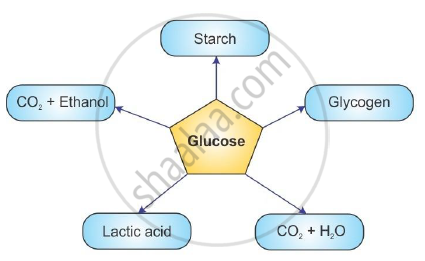Advertisements
Advertisements
प्रश्न
Explain the glycolysis in detail.
उत्तर
Glycolysis was first described by Embden, Meyerhof, and Parnas, and it is commonly referred to as the EMP pathway. This process occurs in the cytoplasm of the cell and is found in all living organisms.
In glycolysis, a molecule of glucose (6-carbon) undergoes partial oxidation to form two molecules of pyruvic acid (3-carbon each). This process is energy-yielding, producing a net gain of 2 ATP molecules and 2 NADH molecules.
The pyruvic acid formed can:
- Enter the Krebs cycle (aerobic respiration) if oxygen is present, where further energy is extracted.
- Undergo fermentation (anaerobic respiration) if oxygen is absent, resulting in the formation of lactate or ethanol, depending on the organism.
The steps involved in the partial oxidation of glucose to form pyruvate are as follows:
APPEARS IN
संबंधित प्रश्न
Given below are the end products of different reactions involving glucose. Write the appropriate end product in front of the following:

(1) Anaerobic reaction =
(2) Reaction in human muscles =
(3) Aerobic respiration
(4) Reaction in plant cells =
(5) Reaction in liver =
Name the life process of an organism that helps in the growth of its population.
What are outside raw materials used for by an organism?
What processes would you consider essential for maintaining life?
Which is the basic requirement of living organisms for obtaining energy?
Match the organisms given in column I with the processes given in column II:
| Column I | Column II | ||
| (i) | Leech | (a) | Holozoic nutrition |
| (ii) | Amoeba | (b) | Autotrophic nutrition |
| (iii) | Mushroom | (c) | Parasitic nutrition |
| (iv) | Green plant | (d) | Saprophytic nutrition |
A person lives near a forest. Make a list of four items which he can get from the forest to meet his daily needs.
Name the green dot like structures in some cells observed by a student when a leaf peel was viewed under a microscope. What is this green colour due to?
Skin : Keratin : : Blood : ____________
Rewrite the food-chain given below with correct sequence.
Grasshopper– Snake– Paddyfield– Eagle– Frog
Write definition
Nutrients
Write the definition.
Proteins
Write definition.
Glycolysis
Distinguish between Glycolysis and TCA cycle.
Give scientific reason.
Oxygen is necessary for complete oxidation of glucose.
Answer in detail.
How all the life processes contribute to the growth and development of the body?
Explain the ‘inhalation’.
Find an odd one out.
What are the main energy sources of living organisms?
Explain the Steps of Glycolysis.
Choose the forms in which most plants absorb nitrogen
- Proteins
- Nitrates and Nitrites
- Urea
- Atmospheric nitrogen
How do the guard cells regulate opening and closing of stomatal pores?
Match the words of Column (A) with that of Column (B)
| Column A | Column B |
| Phloem | (i) Excretion |
| Nephron | (ii) Translocation of food |
| Veins | (iii) Clotting of blood |
| Platelets | (iv) Deoxygenated blood |
In each of the following situations what happens to the rate of photosynthesis?
- Cloudy days
- No rainfall in the area
- Good manuring in the area
- Stomata get blocked due to dust
Match the terms in Column (A) with those in Column (B)
| Column (A) | Group (B) |
| (a) Trypsin | (i) Pancreas |
| (b) Amylase | (ii) Liver |
| (c) Bile | (iii) Gastric glands |
| (d) Pepsin | (iv) Saliva |
Explain the following concept in short:
Balanced Diet
Give scientific reason.
Cell division is one of the important properties of cells and organisms.
Classify vitamins according to their solubility.
Give one example of each of the classifications of vitamins.
